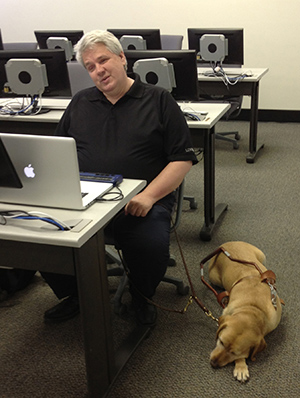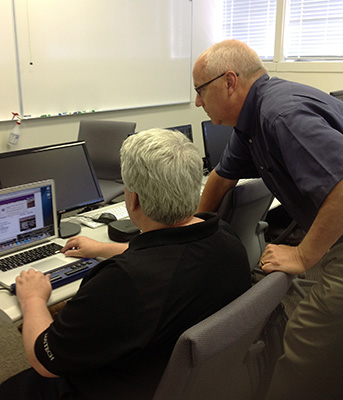J.R. Westmoreland iPhone app
Imagine searching, tweeting, typing, creating, dragging and designing on your laptop. Now close your eyes, and do it without sight.
J.R. Westmoreland, a senior in computer science at Weber State University, and blind since the age of 1, has broken through the visual barrier of app creation by writing an iPhone app prototype from start to finish without assistance.
“As far as we know, this has never been done before,” said Rob Hilton, associate professor of computer science. “J.R. has proven that a blind person can create an app from scratch, even though there is a strong visual component to the process.”
With electrifying speed and accuracy, Westmoreland clicks and drags the cursor across the screen of his laptop. He is assisted by a braille display and a voice-over-screen reader that tells him in a human voice what is on his monitor.
With Hilton’s instruction, Westmoreland learned about the layout and visualization of the development tools. He then used that knowledge to finally envision a little wire connecting the components as he dragged them from point A to point B. He counted up and over and then dropped code, much like playing the game of Battleship in the dark, only much more complex.
“Once he had counted and memorized the lines, then visualized them in his head, we had our Helen Keller moment,” Hilton said. “We jumped up and said, ‘Hey! This is going to work!’”
With Hilton anxiously watching but silent, Westmoreland created an iPhone app prototype using all of the standard Apple tools. “This is a break-through concept,” Westmoreland said. “Now that I can do this, I can create any app, just like a sighted person and hand that code off to somebody else who will do the artwork, such as color, spacing and aesthetics.”
Blind developers are nothing new to computer programming. Westmoreland worked as a programmer and software engineer for 29 years before being laid off at the beginning of the 2008 economic crash.
“I attended Weber State the first time right after high school in 1976 and met my wife here,” Westmoreland said. “I left before completing my degree to accept a job, but after my job dissolved, I decided to finish what I started.”

Hilton first met Westmoreland 30 years ago when they were enrolled in classes together as young freshmen. “He’s always been brilliant and a wizard at computers,” Hilton said. “If you’ve seen a movie like ‘Hackers,’ he has that kind of talent. If he ever turned evil, he could use his genius for a bad purpose.”
According to Westmoreland, the unemployment rate for blind developers is around 75 to 80 percent. Many talented blind developers around the world don’t think that it’s possible for them to program for the new visual-heavy Apple products. “This breakthrough proves that a young blind person today can get involved in programming the most popular new technology, opening doors in higher education and the marketplace,” Westmoreland said.
Hilton’s genuine interest and admiration for his student is evident by the countless hours he spent at Westmoreland’s side working through the glitches, making accommodations and being a cheerleader on his behalf. “I know how hard this stuff is to learn, and I have my sight,” Hilton said. “He’s amazing and fun to watch, and I just think ‘Wow!’ I’m just proud to be a part of it.”
Originally written by Kimberly Jensen for WSU communications


